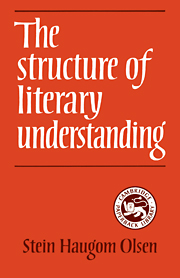Book contents
3 - LITERATURE AND TRUTH
Published online by Cambridge University Press: 30 September 2009
Summary
Introduction
The structuralist theory of language fails to provide a basis for an acceptable theory of literature because it ignores the part played by context or setting in the interpretation of utterances. The literary work as a peculiar kind of utterance cannot be interpreted without reference to some context. The mere presence of textural features (semantic density, ambiguity, metaphor, multiple meanings etc.) or structural features (the interrelation of ‘elements’) is not in itself sufficient to turn a text into a literary work. Such features can be regarded as serving an aesthetic function only when the decision is already taken that the text to which they belong is a literary work. The written or spoken sentence does not carry its function on its face, and this function cannot be determined on the basis of the linguistic features of the utterance alone. An interpretation of an utterance necessarily makes assumptions also about purpose, and its assumed purpose determines how the linguistic and structural features of the utterance are to be construed.
In Dickens' Bleak House there are frequent references to fog, and the fog figures prominently in the description of certain scenes and places. Assume for a moment that Dickens was writing not a literary work but a local history of certain parts of England and that his descriptions of the fog were included for the odd visual effects it had on certain scenes in nineteenth-century London. This assumption would be a part of the reader's interpretation of the text, and it would make his attitude to it different in certain notable ways from what it would have been if he had been reading the text as a literary work.
- Type
- Chapter
- Information
- The Structure of Literary Understanding , pp. 46 - 81Publisher: Cambridge University PressPrint publication year: 1978



